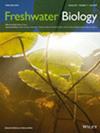Stygobitic Candonidae (Crustacea, Ostracoda) Are Potential Environmental Indicators of Groundwater Quality in Tropical West Africa
IF 2.8
2区 生物学
Q2 ECOLOGY
引用次数: 0
Abstract
- Ostracods are important components of groundwater communities that are influenced by abiotic environmental conditions and biotic interactions. We aimed to identify the factors associated with ostracod assemblages inhabiting groundwaters accessed through dug wells in several regions of Benin in West Africa, exposed to chronic influences of anthropogenic disturbances such as nutrient enrichment from infiltration of sewage or fertilisers from the surface.
- Ostracods were collected from 219 wells in seven catchment areas using two complementary methods: active sampling with a phreatobiological net and passive trapping with a baited trap. Associations with 31 statistical predictor variables (a range of abiotic descriptors of water, hydrology, protection, usage and the type of well) and ostracod occurrence was evaluated using distance-based linear models and redundancy analysis.
- We identified 60 ostracod species representing two ecological groups: 36 species of stygobites of the family Candonidae, an endemic species flock of a vast evolutionary radiation, and 24 species of non-stygobites, mostly of the family Cyprididae. This is the first large groundwater ostracod species flock reported from the entire African continent.
- A number of variables associated with the structure of ostracod assemblages were identified. Except for the descriptors of wells, these included well-known chemical and physical properties (electrical conductivity, pH, temperature or bicarbonate concentration), but also the concentration of NO2−. Although NO2− has not yet been demonstrated to be important for ostracod assemblages, stygobites occurred significantly less frequently in higher concentrations of NO2− than most non-stygobites.
- We determined that stygobitic (candonid) ostracod species and genera may be a good potential environmental indicator of groundwater quality especially nitrite pollution of groundwater in tropical West Africa.
- In tropical West Africa, many human populations rely on groundwater for domestic use and agricultural irrigation, while these aquatic resources are also often affected by anthropogenic disturbances. The use of stygobitic ostracods as potential indicators of groundwater quality offers a valuable tool for environmental monitoring and protection in tropical regions in West Africa, and may be also globally.
西非热带地区潜在的地下水水质环境指标——蛤壳类、介形虫类
介形类是受非生物环境条件和生物相互作用影响的地下水群落的重要组成部分。我们的目标是确定与生活在西非贝宁几个地区通过挖井获得的地下水中的介形虫组合相关的因素,这些地区暴露于人为干扰的长期影响中,例如污水渗透或地表肥料的营养富集。从7个集水区的219口井中采集介形虫,采用两种互补的方法:利用生物网主动采样和利用诱捕器被动捕获。利用基于距离的线性模型和冗余分析,评估了与31个统计预测变量(一系列水、水文、保护、使用和井类型的非生物描述符)和介形虫发生的关联。我们鉴定了60种介形虫,分别代表两个生态类群:36种柱头虫科的柱头虫,这是一个巨大进化辐射的特有物种群;24种非柱头虫,主要是柱头虫科。这是整个非洲大陆报道的第一个大型地下水介形虫种群。鉴定了一些与介形虫组合结构相关的变量。除了井的描述符外,这些描述符还包括众所周知的化学和物理性质(电导率、pH、温度或碳酸氢盐浓度),以及NO2−的浓度。虽然NO2 -尚未被证明对介形虫组合很重要,但在高浓度的NO2 -中,与大多数非stygobite相比,stygobite发生的频率要低得多。研究结果表明,在西非热带地区,蛤壳类介形类的种类和属可能是地下水水质特别是地下水亚硝酸盐污染的潜在环境指标。在热带西非,许多人口依靠地下水进行家庭用水和农业灌溉,而这些水生资源也经常受到人为干扰的影响。使用胶状介形虫作为地下水质量的潜在指标,为西非热带地区的环境监测和保护提供了一个有价值的工具,也可能是全球的。
本文章由计算机程序翻译,如有差异,请以英文原文为准。
求助全文
约1分钟内获得全文
求助全文
来源期刊

Freshwater Biology
生物-海洋与淡水生物学
CiteScore
5.90
自引率
3.70%
发文量
162
审稿时长
2 months
期刊介绍:
Freshwater Biology publishes papers on all aspects of the ecology of inland waters, including rivers and lakes, ground waters, flood plains and other freshwater wetlands. We include studies of micro-organisms, algae, macrophytes, invertebrates, fish and other vertebrates, as well as those concerning whole systems and related physical and chemical aspects of the environment, provided that they have clear biological relevance.
Studies may focus at any level in the ecological hierarchy from physiological ecology and animal behaviour, through population dynamics and evolutionary genetics, to community interactions, biogeography and ecosystem functioning. They may also be at any scale: from microhabitat to landscape, and continental to global. Preference is given to research, whether meta-analytical, experimental, theoretical or descriptive, highlighting causal (ecological) mechanisms from which clearly stated hypotheses are derived. Manuscripts with an experimental or conceptual flavour are particularly welcome, as are those or which integrate laboratory and field work, and studies from less well researched areas of the world. Priority is given to submissions that are likely to interest a wide range of readers.
We encourage submission of papers well grounded in ecological theory that deal with issues related to the conservation and management of inland waters. Papers interpreting fundamental research in a way that makes clear its applied, strategic or socio-economic relevance are also welcome.
Review articles (FRESHWATER BIOLOGY REVIEWS) and discussion papers (OPINION) are also invited: these enable authors to publish high-quality material outside the constraints of standard research papers.
 求助内容:
求助内容: 应助结果提醒方式:
应助结果提醒方式:


